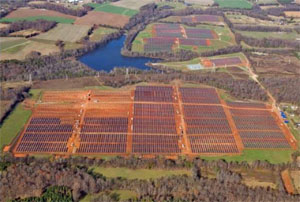Week in review: Solar could power all the world’s needs with little impact, good time for second term of clean energy
 Last week saw some major good news for clean energy. For instance, a recent report from the World Wildlife Fund reaffirms what many in the renewable energy and environmental communities already know, that solar could power all the world’s energy supply with minimal land impact. That’s reassuring for Obama’s second term, who in his second inaugural address called for more clean energy. And that’s just part of the solar news from last week.
Last week saw some major good news for clean energy. For instance, a recent report from the World Wildlife Fund reaffirms what many in the renewable energy and environmental communities already know, that solar could power all the world’s energy supply with minimal land impact. That’s reassuring for Obama’s second term, who in his second inaugural address called for more clean energy. And that’s just part of the solar news from last week.
The recent World Wildlife Federation report, “Solar PV Atlas: solar power in harmony with nature”, found that photovoltaics (PVs) alone could power all the world’s energy needs with sun, with minimal impact to the world’s land. The report was developed by WWF, First Solar, 3TIER and Fresh Generation. It looked at the resources in six countries and one region and found that in each region covering less than 1 percent of the land with solar PV could provide all the energy in the region. The report was released at the World Future Energy Summit in Abu Dhabi, in the United Arab Emirates on Jan. 16.
The news seemed suited to the message for the energy community that President Obama delivered during his second inaugural speech. In his second inaugural address the President declared: “The path towards sustainable energy sources will be long and sometimes difficult. But America cannot resist this transition, we must lead it.” He added that the U.S. cannot let other nations lead the call and move to clean energy and lose those jobs to other nations. During his first term, he already has proved his commitment to clean energy by providing incentives that have led to thousands of megawatts of solar and wind power already installed or being installed now. With the commitment in his inaugural address the U.S. will likely continue down the path toward clean energy.
Meanwhile, where government hasn’t stepped up with all the incentives and ideas needed to help keep solar moving forward, companies are looking for more ways to increase solar. For instance, in Vermont, a trio of companies, Green Mountain Power, National Life Group and Green Lantern Capital, came together to create the GLC Solar Fund, which creates a fund for third-party ownership PV projects, like power-purchase agreements (PPAs) or solar leases. The companies recently installed four pilot projects using the fund and model to help spread the popularity of the option.
Where the state government has funded solar it’s resulted in paybacks. For instance, Hawaii’s solar tax credit is generating $2.67 for every $1 the state invests in the program. That’s according to a recent peer-reviewed study by Blue Planet Foundation. In addition each dollar invested by the state supports 2.7 jobs. In essence both results help make money for the state.
Some solar projects have been criticized for their environmental impacts, particularly to animals that may be at risk. But not all solar projects denigrate the environment or the precious habitats that support such animals and solar companies have taken extraordinary measures—compared to other energy developers like oil or coal. One of the leaders of this type of thinking is 8minutenergy, which develops PV projects on previously disturbed lands. Most recently it worked with the Sierra Club and the Imperial Valley Community Foundation to create a fund that educates people about protecting burrowing owls in California.
To make sure the next generation is aware of solar, it’s helpful to make sure kids are aware of solar. Plus they can help influence their parents to go solar too. Florida Power & Light is realizing this. It recently granted a total of $47,000 to 43 to lead and teach classes in renewable energy projects. The utility began issuing the grants in 2009 and has issued them every year since. Each grant supports between $500 and $2,500 per renewable energy project.



